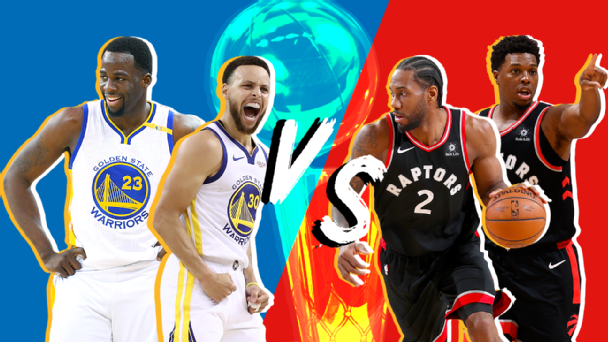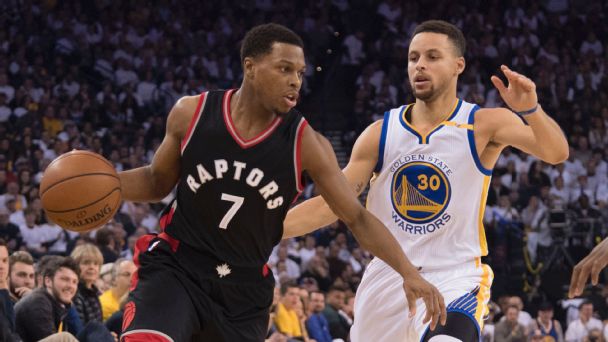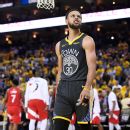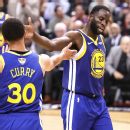OAKLAND, Calif. — It can happen so suddenly — the end of a season, a dynasty, an arena. Few people in and around the NBA had internalized the idea — swirled it around in their brains, digested it, felt it — that the Toronto Raptors, the NBA’s accidental pseudo-contender who catapulted themselves toward something greater with a trade for the ages, could clinch the NBA championship Monday.
The two fans I met from Malaysia who paid more than $10,000 each for tickets to Games 3, 4, and 5 did not expect that they might get to see the series clincher on Monday. One Raptors assistant coach wandered onto the floor after Toronto’s Game 4 decimation of the Golden State Warriors, a bewildered look on his face, and tried to retrieve his wife and two young children from the crowd of 500 or so delirious Raptors fans who stayed half an hour after the game singing songs.
The Raptors are here for lots of reasons, but mostly because of Kawhi Leonard, who has asserted his claim as the world’s best player over the past month. Leonard did something that only LeBron James had approximated before him, and LeBron had help from another all-world scorer in Kyrie Irving, who poured in 90 combined points over the last three games of the 2016 Finals — when the Cleveland Cavaliers completed the unprecedented comeback Golden State will attempt now.
Leonard broke the Warriors.
If there was a moment when you knew it, perhaps this was it:
That is what Leonard had reduced Golden State to: leaving Danny Green, one of the great 3-point shooters in NBA Finals history, wide open in the strong-side corner — a no-no against even average shooters. A team that does that is desperate. A team that does that is out of answers. It has lost itself.
I asked Green in the locker room after the game if he was surprised to be left so open. “That open? Yes.” Green said. “But teams have been doing that. You’ve got [Leonard], a special guy, going off, and you gotta help from somewhere.”
Throughout these strange, injury-ravaged Finals, there has been a debate over how much help the Warriors should send at Leonard — that perhaps they should let Leonard “get his,” or try to, and stay closer to Toronto’s army of outside shooters. Nick Nurse, Toronto’s head coach, said he felt Golden State creeping toward the right balance in the Warriors’ Game 2 win.
Find everything you need to know about the NBA Finals here.
He urged his team to veer just a bit away from the pick-and-roll — to use more off-ball screening and cutting.
“They’ve done a great job of clogging up our pick-and-rolls,” Nurse told ESPN after Game 3. “We’ve got stuck in them a lot. So we tried to get away from them a little — a little more cutting.” The Raptors, at times, looked like the old-school, Kevin-Durant-less Warriors.
When they ran the NBA’s staple play, Nurse pushed his players to vary both the combinations of players involved and the techniques. So there was Leonard in the second half of Game 3 scampering up the right wing to screen for Pascal Siakam, a nominal power forward who’s really just a Pascal Siakam, only Leonard never set the screen; he darted suddenly away from Siakam and toward the top of the arc, earning just enough separation from a temporarily startled Draymond Green to ease into an open catch-and-shoot 3.
Kyle Lowry executed the same slip-the-screen trickery with Leonard — fading out to the right wing on a cut in Game 3 that jumbled Golden State’s defense and conjured another open look.
Lowry and Leonard struggled to develop the sort of two-man chemistry Lowry enjoyed with DeMar DeRozan. Lowry was startlingly passive for the first 40 or 50 games of the season. Even in grinding through these playoffs, the Lowry-Leonard pick-and-roll — such an enticing weapon, something that should be an automatic mismatch generator — never really got rolling.
Until Game 3. “For me, it has been adjusting to what he does,” Lowry told ESPN before Game 4.
The Warriors couldn’t dictate how much help they might send at Leonard — and when — if they didn’t know what was coming.
At times in Game 4, the Raptors let Leonard work without a pick. He bludgeoned Golden State, drawing fouls and rising for long 2s:
Leonard has a unique combination of footwork and strength. Defenders bounce off him, he hits the brakes, and what looked half a second ago like a difficult shot becomes a 50/50 proposition. That is the ultimate playoff weapon. When there are only four and then two teams alive, you don’t get to pick the shots you want. You take the shot you get, or the shots you are given, and make the best out of them. Those shots allow Toronto to control the tempo of the series.
Leonard is an absolute battering ram. When Kevon Looney, replacing the shade of DeMarcus Cousins, pressured Leonard on the pick-and-roll in Game 4, Leonard revealed counter after counter.
He waited out the trap, and coaxed Looney into retreating with a canny pass fake to Marc Gasol. And then he just kind of meandered and burrowed to where he wanted to go. When he rose up, Looney rose with him — exposing a 2-on-1 under the rim. Looney probably should have let Andre Iguodala handle Leonard alone there. That is the kind of thing you say when you haven’t watched Leonard rain midrange death on everyone for the past two months.
From there, it’s Siakam to Gasol on a gorgeous sequence that is emblematic in its own way of how Toronto has pushed the Curry-era Warriors into the deepest hole it has ever faced — with or without Durant. When the Warriors loaded up Leonard in Game 4, he trusted the other Raptors, and they paid off that trust with some of their best passing sequences of their postseason.
Ibaka makes the first pass to his most convenient release valve — Lowry — and keeps going. Lowry follows with the give-back — the pass the defense doesn’t expect.
By the fourth quarter, the Warriors didn’t know what was coming. A defense that has spent the past half-decade playing one step ahead — sneering and roaring at opponents who didn’t expect them to pop up right there — was suddenly playing from two steps behind. Those are the sorts of sequences Masai Ujiri and his staff envisioned when they acquired Gasol. They essentially bet that adding one more passing hub — a big man equivalent to Lowry — would give them access to a different style of offense when they needed one.
The passing carried over into those precarious minutes at the start of the second and fourth quarters when Nurse rested Lowry and Leonard at the same time. (If the Warriors can’t win those minutes, they are toast.)
Ibaka has thrown three or four inside-out passes like that over the past two games. They have been some of the finest passes of his career. Ibaka is still not exactly a good passer. He is probably the worst passer in Toronto’s playoff rotation. He doesn’t read the floor as fast, or possess the sense of anticipation of Lowry and Gasol. But he has worked at it. The work is painstaking, boring, outside his skill set. It has paid off over these past few games, including Game 4, one of the best of Ibaka’s career.
When I entered the Raptors’ locker room after Game 4, Ibaka and Green were standing facing each other; Ibaka was reenacting a sequence in which he had demurred on a contested floater and touched a pass to Siakam in the corner. He was proud. Green told him he remembered the play. They dissected it together.
Both Ibaka and Gasol over the past two games in Oracle Arena ramped up their rolling to the rim. Both prefer to pop for jumpers, or flare out for dribble handoffs. But they and Nurse’s coaching staff noticed they could get behind Cousins and Andrew Bogut if they cut hard out of screens for Leonard and Lowry, and it worked. They both dunked, and drew fouls. Gasol drew help, and dished to corner shooters.
That’s a simple play, but it stands out as unusual for Leonard — an early pass, not one that comes only after the defense has swarmed him.
Leonard even hid down in the dunker spot, usually a place for bit players, as Ibaka and Fred VanVleet worked the pick-and-roll late in the third quarter Friday; he floated under the play and across the paint for a bucket to put Toronto up by 12. That was not vintage Leonard. That was unexpected Leonard.
The Raptors have a 3-1 lead on the defending champs. Will they clinch the title at home? Tune in here.
Monday, June 10
• Game 5 | 9 p.m. ET | ABC/WatchESPN
Thursday, June 13
• Game 6* | 9 p.m. ET | ABC/WatchESPN
*If necessary
To get this close to a title, you have to be a shapeshifter on both ends. A team that was once predictable and monotonous has proven itself such even though its lead superstar is not known as a playmaker. They have toggled seamlessly from one variety of half-court set to another, and another, and another. When they sensed chances to run, they ran.
It all starts with Leonard — his ability to both start and finish possessions in a variety of ways and dictate pace. We spend a lot of time nitpicking stars who fail by some impossible Jordanian standard in the playoffs. Some of that is dumb noise — Damian Lillard hitting the second series-ending buzzer-beater of his career, and two rounds later facing questions about his viability as a postseason superstar.
Some of it is interesting and worthwhile: Is Chris Paul’s career proof of the difficulty in building around a 6-foot player? What does it mean that James Harden has underperformed his incredible regular-season standards by 5 or 10 percent in most postseasons? The playoffs are harder than the regular season. Perhaps some slippage should be expected. But the questions are legitimate.
Perhaps we have not spent enough time amid all of that calling Leonard what he now indisputably is: one of the greatest postseason performers in the history of the sport, the rare superstar who gets better in the playoffs.
Leonard won Finals MVP in 2014, a year after exploding as a 21-year-old in the 2013 Finals. He averaged 28 points, 8 rebounds and 5 assists in the 2017 playoffs — and locked up everyone on defense — before one false Zaza Pachulia step ended his season, and really his San Antonio career.
In Game 4 of the first round against Memphis that year, Leonard scored 43 points and swiped six steals in almost single-handedly dragging the Spurs to a win in one of those incredible feats that gets lost in history because it happened in an unremarkable first-round series.
1 Related
He took the ball on one end, and scored on the other. He almost didn’t need help. The memory of that game popped back up when Leonard opened the second half of Game 4 Friday with a 3-pointer, a steal, and another 3-pointer to give Toronto the lead.
He is one of two players to have logged at least 1,000 career postseason minutes, and shoot at least 50% overall and 40% from 3-point range. (Al Horford is the other, at much lower long-range volume.)
He hit an all-time shot to win Game 7 against Philadelphia in the second round, and turned the next series when Nurse assigned him to Giannis Antetokounmpo in Game 3. But don’t forget the triple Leonard hit over Joel Embiid with one minute left in Game 4 against Philadelphia to put Toronto up 94-90 — on the road, and trailing the Sixers two games to one. Talk to people within the Raptors, and they’ll tell you that game — and the time between Game 3 and Game 4 of that series — was their point of greatest stress in these playoffs.
Philadelphia overwhelmed them in Game 3. The Sixers’ size troubled Toronto. The Raptors would have to summon more than they had expected. Leonard’s shot held off a potential doomsday scenario.
Now he has them one win from history. If they finish the Warriors, some will cry “asterisk” because of injuries to Durant and Klay Thompson. Game 3 was indeed a bummer. It did not feel like a Finals game.
But you can only play the teams in front of you. Every postseason is marked by some important injury. Thompson missed only that one game, and the Warriors came into these Finals having won six straight playoff games — and 31 of 32 overall — when Curry played without Durant.
The Warriors are giants, as Steve Kerr called them after their Game 5 win over Houston. Never count them out. Toronto has work to do, still. Leonard will be ready.
Credit: Source link

